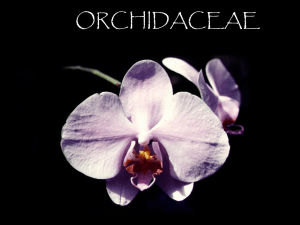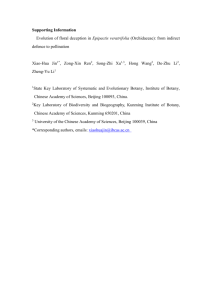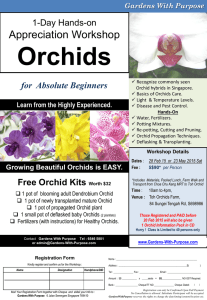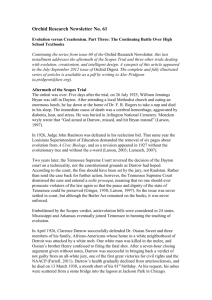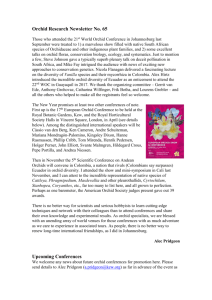ELECTRONIC SUPPLEMENTARY MATERIAL: This ESM contains
advertisement
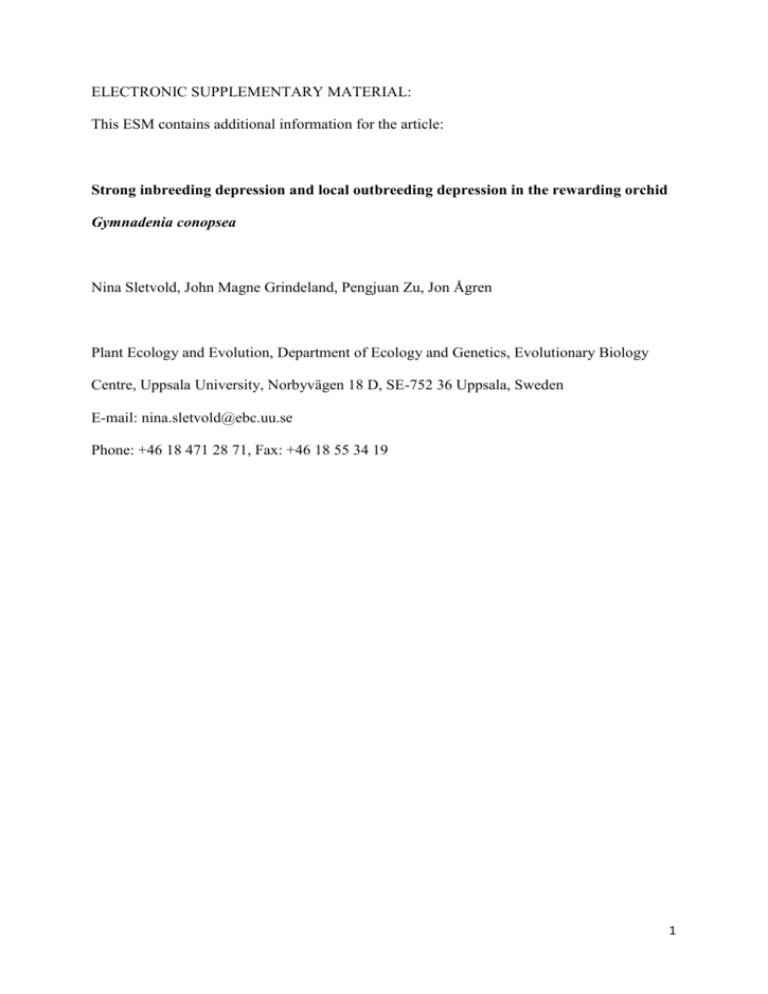
ELECTRONIC SUPPLEMENTARY MATERIAL: This ESM contains additional information for the article: Strong inbreeding depression and local outbreeding depression in the rewarding orchid Gymnadenia conopsea Nina Sletvold, John Magne Grindeland, Pengjuan Zu, Jon Ågren Plant Ecology and Evolution, Department of Ecology and Genetics, Evolutionary Biology Centre, Uppsala University, Norbyvägen 18 D, SE-752 36 Uppsala, Sweden E-mail: nina.sletvold@ebc.uu.se Phone: +46 18 471 28 71, Fax: +46 18 55 34 19 1 References included in Table 3: Ackerman JD, Montalvo AM (1990) Short and long term limitations to fruit production in a tropical orchid. Ecology 71:263–272. Beardsell DV, Clements MA, Hutchinson JF, Williams EG (1986) Pollination of Diuris maculata R. Br. (Orchidaceae) by floral mimicry of the native legumes Daviesa spp. and Pultenaea scabra R. Br. Austr. J. Bot. 34:165–173. Bellusci F, Pellegrino G, Musacchio A (2009) Different levels of inbreeding depression between outcrossing and selfing Serapias species. Biol. Plant. 53:175–178. Borba EL, Sheppard GJ, Semir J. (1999) Reproductive systems and crossing potential in three species of Bulbophyllum (Orchidaceae) occurring in Brazilian ‘campo rupestre’ vegetation. Plant Syst. Evol. 217:205–214. Ellis AG, Johnson SD (1999) Do pollinators determine hybridization patterns in sympatric Satyrium (Orchidaceae) species? Plant Syst. Evol. 219:137–150. Ferdy JB, Loriot S, Sandmeier M, Lefranc M, Raquin C (2001) Inbreeding depression in a rare deceptive orchid. Can. J. Bot. 79:1181–1188. Fritz A-L (1990) Deceit pollination of Orchis spitzelii (Orchidaceae) on the island of Gotland in the Baltic: a suboptimal system. Nordic J. Bot. 9:577–587. Gregg KB (1989) Reproductive biology of the orchid Cleistes divaricata (L.) Ames var. bifaria Fernald growing in a West Virginia meadow. Castanea 54: 57–78. Johnson SD (1994) Evidence for Batesian mimicry in a butterfly-pollinated orchid. Biol. J. Linn. Soc. 53:91–104. Johnson SD (2000) Batesian mimicry in the nonrewarding orchid Disa pulchra, and its consequences for pollinator behaviour. Biol. J. Linn. Soc. 71:119–132. 2 Johnson SD, Steiner K (1997) Long-tongued fly pollination and evolution of floral spur length in the Disa draconis complex (Orchidaceae). Evolution 51:45–53. Johnson SD, Alexandersson R, Linder, HP (2003) Experimental and phylogenetic evidence for floral mimicry in a guild of fly-pollinated plants. Biol. J. Linn. Soc. 80:289–304. Johnson SD, Torninger E, Ågren J (2009) Relationships between population size and pollen fates in a moth-pollinated orchid. Biol. Lett. 5:282–285. Juillet N, Dunand-Martin S, Gigord LDB (2007) Evidence for inbreeding depression in the food-deceptive colour-dimorphic orchid Dactylorhiza sambucina (L.) Soò. Plant Biol. 9:147–151. Kallunki JA (1981) Reproductive biology of mixed-species populations of Goodyera (Orchidaceae) in northern Michigan. Brittonia 33:137–155. Lammi A, Vallius E, Vauhkonen T, Kuitunen M (2003) Outcrossing, hybridization, pollen quantity, and the evolution of deceptive pollination in Dactylorhiza incarnata. Ann. Bot. Fenn. 40:331–338. Larsen MW, Peter C, Johnson SD, Olesen JM (2008) Comparative biology of pollination systems in the African-Malagasy genus Brownleea (Brownleeinae: Orchidaceae). Bot. J. Linn. Soc. 156:65–78. Luyt R, Johnson SD (2001) Hawkmoth pollination of the African epiphytic orchid Mystacicium venosum, with reference to flower and pollen longevity. Plant Syst. Evol. 228:49–62. Meléndez-Ackerman EJ, Ackerman JD. (2001) Density-dependent variation in reproductive success in a terrestrial orchid. Plant Syst. Evol. 227:27–36. Montalvo AM, Ackerman JD (1987) Limitations to fruit production in Ionopsis utricularioides. Biotropica 19:24–31. 3 Nilsson LA (1980) The pollination ecology of Dactylorhiza sambucina (Orchidaceae). Botaniska Notiser 133:367–385. Nilsson LA (1981) The pollination ecology of Listera ovata (Orchidaceae). Nordic J. Bot. 1:461–480. Nilsson LA (1983) Processes of isolation and introgressive interplay between Platanthera bifolia (L.) Rich and P. chlorantha (Custer) Reichb. (Orchidaceae). Bot. J. Linn. Soc. 87:325–350. Nilsson LA (1984) Anthecology of Orchis morio (Orchidaceae) at its outpost in the north. Nova Acta Reg. Soc. Sci. Upsal. 3:167–179. Nilsson LA, Rabakonandrianina E, Razananaivo R, Randriamanindry JJ (1992) Long pollinia on eyes: hawk-moth pollination of Cynorkis uniflora Lindley (Orchidaceae) in Madagascar. Bot. J. Linn. Soc. 109:145–160. Patt JM, Merchant MW, Williams DRE, Meeuse BJD (1989) Pollination biology of Platanthera stricta (Orchidaceae) in Olympic National Park, Washington. Am. J. Bot. 76:1097–1106. Peakall R (1989) The unique pollination of Leporella fimbriata (Orchidaceae): pollination by pseudocopulating male ants (Myrmecia urens, Formicidae). Plant Syst. Evol. 167:137– 148. Peakall R, Beattie AJ (1989) Pollination of the orchid Microtis parviflora R. Br. by flightless worker ants. Funct. Ecol. 3:515–522. Peakall R, Beattie AJ (1996) Ecological and genetic consequences of pollination by sexual deception in the orchid Caladenia tentaculata. Evolution 50:2207–2220. Salguero-Faría JA, Ackerman JD (1999) A nectar reward: is more better? Biotropica 31:303– 311. 4 Sletvold N, Grindeland JM, Zu P, Ågren J. Strong inbreeding depression and local outbreeding depression in the rewarding orchid Gymnadenia conopsea. Cons. Gen.: this issue. Steiner KE, Whitehead VB, Johnson SD (1994) Floral and pollinator divergence in two sexually deceptive South African orchids. Am. J. Bot. 81:185–194. Tremblay RL, Ackerman JD, Zimmerman JK, Calvo RN (2005) Variation in sexual reproduction in orchids and its evolutionary consequences: a spasmodic journey to diversification. Biol. J. Linn. Soc. 84:1–54. Vallius E (2000) Position-dependent reproductive success of flowers in Dactylorhiza maculata (Orchidaceae). Funct. Ecol. 14:573–579. Wallace LA (2003) The cost of inbreeding in Platanthera leucophaea (Orchidaceae). Am. J. Bot. 90:235–242. 5
